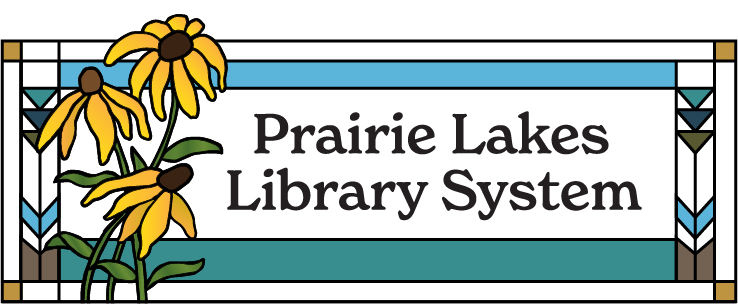Have a poppin’ good time with several different science experiments and lots of opportunities to sample America’s favorite snack!
Diversity, Equity, and Inclusion: Library programming is designed to be fully inclusive. Age limits may be implemented in certain programs to ensure that program content fosters appropriate developmental markers.
Accessibility: Provide magnifying glasses for students who may need vision support. To help hold jars/vases for those with low motor skills, cut circles the same size as the jars into a thick piece of upcycled styrofoam.
Mode: Facilitated
Staff Energy: High
Ages: 5-12
Cost: Moderate
Length: 75-90 min.
Ideal Attendance: 15
STEAM Practices:
✓ Science (observation, experimentation)
Tags: food, kids, tweens, multiple activities, science
Credit: Kate Davis
Supplies:
(Commonly on-hand supplies are not included in cost breakdown.)
- Dried corn kernels (½ cup for each group of 2-3 kids) $2.28/32 oz. bag
- Popped popcorn (for experimenting) $30
- Carmel corn (for experimenting) $30
- Baking soda (¼ cup for each group) $2.08
- White vinegar (approx. 2 cups per group, but this depends on size of glass jar) $3.94
- Transparent glass jars/vases (1 per 2-3 kids) ($1.25/ea) $6.25
- Disposable aluminium baking trays ($1.25/2) $11.25
- Measuring cups
- Disposable cups (3 per station)
- Straws
- Paper towels
- Table coverings
- Large bowl for snack popcorn
- Scoop/disposable cup for scooping snack popcorn
- Spoons for scooping choc chips and m&m’s
- Napkins
- About 2 cups popped popcorn per participant for snack (incl. in above pricing)
- 2 tsp. chocolate chips per participant ($4/bag)
- 2 tbsp mini M&Ms per participant ($4/bag)
- kosher salt
- baggies
Instructions: Activity 1: Dancing Popcorn
Tell the kids that science is going to make popcorn kernels dance! Ask what their favorite dance songs are and if you have a partner helping with the program, have them play some of the songs during the experiment.
Have the kids investigate the ingredients–touch, smell, taste, and talk about what those properties are.
Have them pour kernels into the jar, then cover the kernels with vinegar. Ask what they predict will happen when they add baking soda.
Slowly add baking soda. This is when the kernels will start rising and falling in the vinegar. Ask the kids for any guesses why this is happening. Tell them it’s happening because of a chemical reaction! A chemical reaction takes place when two or more substances (ingredients) interact to form a new substance.
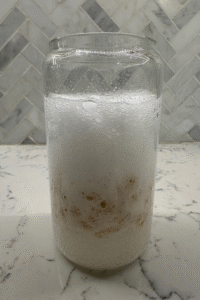
In this case, the acid (vinegar) and the base (baking soda) mix to create a gas called carbon dioxide, which causes the reaction they’re seeing. The bubbles they see are actually carbon dioxide. They are lifting the corn up. When those bubbles pop, the corn sinks to the bottom again.
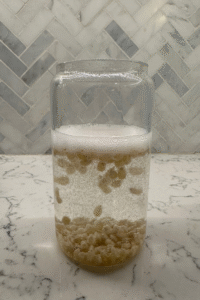
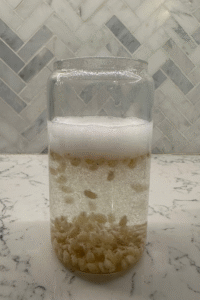
The corn should dance for about 15 minutes or more.
Reactivate the process by stirring it gently with the straw. Alternately, add more baking soda.
If you have any other small, dry foods on hand (beans, nuts, cranberries, etc.), it is fun to compare and contrast their reactions to the kernels’.
Instructions: Activity 2: Popcorn in Milk
Give each kid a few pieces of popped popcorn. Encourage them to inspect, squish, nibble, etc. and try to put names to what they are observing–crunch, squeak, dissolve, soft, etc. (You might want to provide magnifying glasses for up-close observations.)
Ask them what they think the structure of the popcorn is made of (strands of starch and air).
Fill one glass about ½ a centimeter from the top with milk. (You can do this in advance or have the kids do it. If the kids are doing it, place the top of a piece of masking or painter’s tape at the level they need to fill to.)
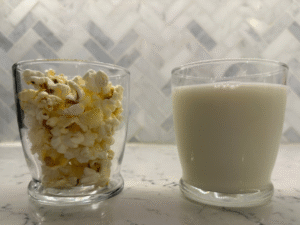
Fill the second glass to the same spot with air-popped popcorn. (Again, you can do this in advance or have the kids do it. If the kids are doing it, place the top of a piece of masking or painter’s tape at the level they need to fill to.)
Slowly place the popcorn into the glass of milk.
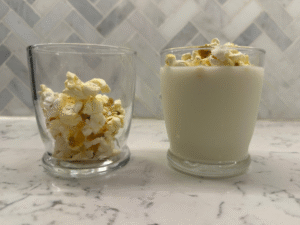
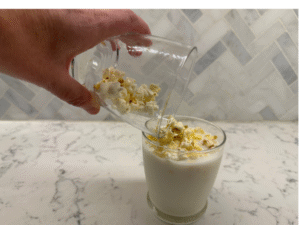
Continue until all of the popcorn is in the glass of milk.
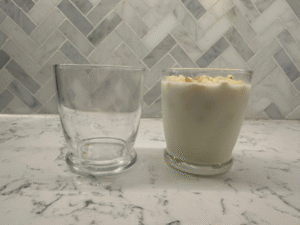
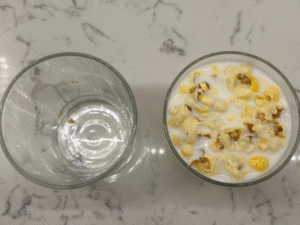
Make observations and hypotheses as to why the same volume of popcorn fits into the glass of milk without causing it to overflow. Did the popcorn change size when wet? Did it make a sound?
Repeat steps 1-5 with caramel popcorn.
Discuss the differences between the plain popcorn and caramel popcorn. What were the differences? Did the same thing happen? If not, why?
Instructions: Activity 3: Sweet & Salty Snacking
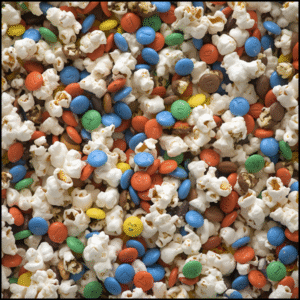
Serves 5; makes about 10 cups popped popcorn
⅓ cup chocolate chips
½ teaspoon kosher salt
½ cup mini M&Ms or chopped regular M&Ms
Place the chocolate chips into a microwave safe bowl and heat for 30 second intervals, stirring between each one, until the chocolate is melted and smooth.
While it’s melting, have kids take a couple scoops of popcorn, sprinkle it with salt, then add some mini- M&M’s.
Give the kids a spoon and let them drizzle melted chocolate onto their popcorn.
Enjoy! Point out to the kids that in a few minutes, the chocolate will harden because the fats in chocolate, primarily cocoa butter, solidify when they cool down to room temperature or below. (Chocolate melts at 120-130 degrees.)
Recipe credit: https://meaningfuleats.com/mm-popcorn-easy-recipe/#wprm-recipe-container-38012
Staff Know-How
Planning, Set Up & Facilitation
Activity 1: Dancing Popcorn prep work
- Measure out kernels, baking soda, and vinegar into disposable cups for each station. (2-3 kids can work at a station.) (Alternatively, you can have kids measure the ingredients themselves.)
- Set glass jars, ingredients, and straws on top of baking trays.
- Have some dance party music playing when the kids come in.
Activity 2: Popcorn in Milk prep work
Before starting this experiment, provide a quick overview about volume—the amount of space an object takes up. Volume is a physical property, like height and weight, and is measured in cubic units for 3-dimensional objects. For regular shapes, you can calculate volume by multiplying length, width, and height (e.g., a rectangular container). For irregular objects, use water displacement: when an object is submerged in water, it pushes water out, and the amount displaced equals the object’s volume.
For example, if a ball raises water from 12.5 mL to 17.5 mL in a graduated cylinder, its volume is 5 mL. Popcorn, being an irregular object, might require water displacement, but because its sides are filled with air, measuring can be tricky, as water fills those air pockets. This raises the question of how to accurately measure the popcorn’s volume without collapsing the popcorn’s structure.
(Explanation paraphrased from Popcorn Bistro.)
Activity 3: Sweet & Salty Snacking prep work
After all that experimenting, kids will need a snack! Give them bowls, spoons, and some basic ingredients, and let them stir up a treat! This does require melted chocolate, so you may need to have a staff member on hand to help. (Alternatively, you could use a mini slow cooker.)
Pro-Tips
- Make some sweet and salty popcorn for coworkers!
- Have kids clean up their stations (including the floor) after each activity.
Marketing & Promo
Book Suggestions
Popcorn Science book list template
Resources are availabe in the SHARE catalog as of May 2025.
50 STEM labs : science experiments for kids (Frinkle, Andrew)
The science spell book : magical experiments for kids (Florance, Cara)
10-minute science experiments : 50 quick, easy & awesome projects for kids (Spangler, Steve)
The ultimate science cookbook for kids : 75+ edible experiments (Highlights for Children)
The science chef : 100 fun food experiments and recipes for kids (D’Amico, Joan)
Reusability
Aluminium baking trays can be used over and over as craft/paint/hot glue/experiment trays.
Used corn kernels can be dried thoroughly and kept for a future program.
Glass jars can be used for future adult crafts, library decor, event decor
Unused corn kernels can be used for future crafts, experiments or sensory bins.
Remaining baking soda can be used for future experiments, slime, etc.
